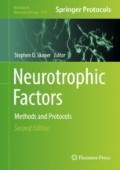Abstract
Hippocampal organotypic cultures constitute a very easy but delicate method widely used to study amyloid β-peptide toxicity. This ex vivo technique is performed on tissues isolated from newborn rats. Here, we describe a protocol for the preparation and culture of hippocampal organotypic slices that can be maintained for 14–21 days and their application to the study of amyloid β-peptide toxicity.
References
Reinbold R (1954) Organotypic differentiation of the eye of the chick embryo in vitro. C R Seances Soc Biol Fil 148:1493–1495
Scuderi C, Valenza M, Stecca C et al (2012) Palmitoylethanolamide exerts neuroprotective effects in mixed neuroglial cultures and organotypic hippocampal slices via peroxisome proliferator-activated receptor-α. J Neuroinflammation 9:49. https://doi.org/10.1186/1742-2094-9-21
Harwell CS, Coleman MP (2016) Synaptophysin depletion and intraneuronal Aβ in organotypic hippocampal slice cultures from huAPP transgenic mice. Mol Neurodegener 11:44. https://doi.org/10.1186/s13024-016-0110-7
Müller M, Gähwiler BH, Rietschin L et al (1993) Reversible loss of dendritic spines and altered excitability after chronic epilepsy in hippocampal slice cultures. Proc Natl Acad Sci U S A 90:257–261
Gähwiler BH, Capogna M, Debanne D et al (1997) Organotypic slice cultures: a technique has come of age. Trends Neurosci 20:471–477
Stoppini L, Buchs PA, Muller D (1991) A simple method for organotypic cultures of nervous tissue. J Neurosci Methods 37:173–182
Shamir ER, Ewald AJ (2014) Three-dimensional organotypic culture: experimental models of mammalian biology and disease. Nat Rev Mol Cell Biol 15:647–664. https://doi.org/10.1038/nrm3873
Ullrich C, Daschil N, Humpel C (2011) Organotypic vibrosections: novel whole sagittal brain cultures. J Neurosci Methods 201:131–141. https://doi.org/10.1016/j.jneumeth.2011.07.021
Pellegrini-Giampietro DE, Cozzi A, Peruginelli F et al (1999) 1-Aminoindan-1,5-dicarboxylic acid and (S)-(+)-2-(3′-carboxybicyclo[1,1,1]pentyl)-glycine, two mGlu1 receptor-preferring antagonists, reduce neuronal death in in vitro and in vivo models of cerebral ischemia. Eur J Neurosci 11:3637–3647. https://doi.org/10.1046/j.1460-9568.1999.00786.x
Finley M, Fairman D, Liu D et al (2004) Functional validation of adult hippocampal organotypic cultures as an in vitro model of brain injury. Brain Res 100:125–132
Scuderi C, Steardo L (2013) Neuroglial roots of neurodegenerative diseases: therapeutic potential of palmitoylethanolamide in models of Alzheimer’s disease. CNS Neurol Disord Drug Targets 12:62–69
Hardy J, Selkoe DJ (2002) The amyloid hypothesis of Alzheimer’s disease: progress and problems on the road to therapeutics. Science 297:353–356
Opitz-Araya X, Barria A (2011) Organotypic hippocampal slice cultures. J Vis Exp 48:2462. https://doi.org/10.3791/2462
Stine WB, Jungbauer L, Yu C, LaDu MJ (2011) Preparing synthetic Aβ in different aggregation states. Methods Mol Biol 670:13–32. https://doi.org/10.1007/978-1-60761-744-0_2
Paxinos G, Watson C (1998) The rat brain in stereotaxic coordinates, 4th De Luxe edn. Elsevier Science Publishing Co Inc., San Diego
Franklin KBJ, Paxinos G (2001) The mouse brain in stereotaxic coordinates, 2nd revised edn. Elsevier Science Publishing Co Inc, San Diego
Acknowledgement
This work was supported by SAPIENZA University Grant to CS (prot. C26A15X58E).
Author information
Authors and Affiliations
Corresponding author
Editor information
Editors and Affiliations
Rights and permissions
Copyright information
© 2018 Springer Science+Business Media, LLC
About this protocol
Cite this protocol
Bronzuoli, M.R., Facchinetti, R., Scuderi, C. (2018). Preparation of Rat Hippocampal Organotypic Cultures and Application to Study Amyloid β-Peptide Toxicity. In: Skaper, S. (eds) Neurotrophic Factors. Methods in Molecular Biology, vol 1727. Humana Press, New York, NY. https://doi.org/10.1007/978-1-4939-7571-6_24
Download citation
DOI: https://doi.org/10.1007/978-1-4939-7571-6_24
Published:
Publisher Name: Humana Press, New York, NY
Print ISBN: 978-1-4939-7570-9
Online ISBN: 978-1-4939-7571-6
eBook Packages: Springer Protocols

